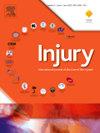Biomechanical evaluation of novel 3D-printed magnesium alloy scaffolds for treating proximal humerus fractures with medial column instability
IF 2.2
3区 医学
Q3 CRITICAL CARE MEDICINE
Injury-International Journal of the Care of the Injured
Pub Date : 2025-03-18
DOI:10.1016/j.injury.2025.112266
引用次数: 0
Abstract
Background
Patients with complex proximal humerus fractures (PHFs) have a higher complication rate when treated with locking compression plate (LCP) alone. This increased complication rate may be due to humeral head collapse and insufficient medial column support in the proximal humerus. In response, we proposed the use of bionic porous 3D-printed magnesium alloy scaffolds (MAS) in combination with LCP for the treatment of PHFs. The aim of this study is to compare the biomechanical characteristics of the LCP alone versus LCP-MAS fixation constructs in treating PHFs with medial column instability.
Methods
A three-dimensional model of a PHF with medial column instability was developed using computed tomography, and fixation was applied using LCP and LCP-MAS. Finite element analysis was employed to evaluate the biomechanical characteristics of these two fixation models, focusing on construct stiffness, von Mises stress distribution, and fracture displacements.
Results
The construct stiffness of the LCP-MAS fixation construct was approximately 3.50 to 7.30 times greater than that of the LCP fixation construct under normal bone conditions, and 2.60 to 4.90 times greater under osteoporotic bone conditions. The LCP-MAS fixation reduced the maximum von Mises stress on the implants by at least 70 %-80 %. Furthermore, the LCP-MAS fixation significantly minimized fracture displacement compared to LCP alone.
Conclusions
The findings of this study suggest that the additional use of MAS can significantly enhance both the overall and local stability of PHFs. Thus, the LCP-MAS fixation approach presents a viable alternative for the treatment of PHFs.
求助全文
约1分钟内获得全文
求助全文
来源期刊
CiteScore
4.00
自引率
8.00%
发文量
699
审稿时长
96 days
期刊介绍:
Injury was founded in 1969 and is an international journal dealing with all aspects of trauma care and accident surgery. Our primary aim is to facilitate the exchange of ideas, techniques and information among all members of the trauma team.

 求助内容:
求助内容: 应助结果提醒方式:
应助结果提醒方式:


